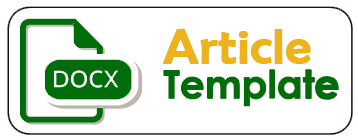Model Optimasi Segmentasi Tumor Otak Dalam Magnetic Resonance Imaging Berbasis Fuzzy C-Means Dan Simulated Annealing
DOI:
https://doi.org/10.32497/orbith.v21i2.6708Keywords:
Tumor Otak, Segmentasi, Fuzzy C-Means, Simulated AnnealingAbstract
Tumor otak atau biasa disebut dengan Brain Tumour merupakan salah satu jenis penyakit otak yang terjadi akibat evolusi sel secara abnormal dan tidak dapat dikontrol (uncontrolled) di dalam otak. Untuk mendeteksi tumor otak, para dokter biasa menggunakan Magnetic Resonance Imaging (MRI). MR Images merupakan teknik pencitraan medis yang dapat menampilkan informasi tentang anatomi jaringan lunak manusia. MR Images mampu menghasilkan gambar dengan kualitas tinggi dari struktur anatomi otak manusia. Hal ini menjadikan deteksi tumor melalui MR Images dipandang sebagai sesuatu yang penting dan krusial. Untuk melakukan deteksi tumor otak, diperlukan rangkaian tahap penelitian yang pada hasil akhirnya berupa tahapan klasifikasi. Salah satu tahapan penting pada rangkaian tahapan tersebut adalah tahapan segmentasi. Segmentasi citra pada MR Images dapat memisahkan objek tumor dengan objek non-tumor. Salah satu metode yang digunakan untuk melakukan segmentasi adalah Fuzzy C-Means (FCM). Penggunaan FCM sebagai metode segmentasi memiliki kelemahan, yaitu cluster yang dihasilkan tidak 100% berkualitas (misclustred). Untuk mengatasi masalah tersebut, maka diusulkan metode Simulated Annealing (SA) sebagai metode optimasi. Dengan metode optimasi SA ini, kualitas cluster pada proses segmentasi dapat memperoleh hasil yang optimal. Hal ini terlihat dari menurunnya nilai Xie-Beni hingga 7 (tujuh) kali lipat dibandingkan dengan segmentasi menggunakan FCM saja.
References
Anggri Yulio P., 2017. Operasi Morfologi Pada Pengolahan Citra. [Online] Available at: https://devtrik.com/opencv/operasi-morfologi-pada-pengolahan-citra [Accessed 17 April 2017]
Central Brain Tumor Registry Of the United State CBTRUS., 2016. [Online] Available at: http://www.cbtrus.org/factsheet/factsheet.html [Accessed 8 Maret 2017]
C.Immaculate, Mary., S.V, Kasmir Raja., 2010. Improved Fuzzy C-Means Clusters With Ant Colony Optimization, International Journal of Computer Science & Emerging Technologies, vol. 1, no. 4.
Ozgur, Baskan., Soner, Haldenbilen., Huseyin, Ceylan., and Halim, Ceylan., 2009. A new solution algorithm for improving performance of ant colony optimization, in Applied Mathematics and Computation 211.
Peiyu., Linshan., Xuezhi, CHI, Shandong., and Zhenfang, ZHU, 2013. An Improved Fuzzy C-means Clustering Algorithm Based on Simulated Annealing, 10th International Conference on Fuzzy Systems and Knowledge Discovery.
Robyn Owens., 1997. Mathematical Morphology. [Online] Available at: http://homepages.inf.ed.ac.uk/rbf/CVonline/LOCAL_COPIES/OWENS/LECT3/node3.html [Accessed 17 April 2017]
S, Kirkpatrick., C.D, Gelatt, and M, P, Vecchi., 1983. Optimization by Simulated Annealing, Science, vol. 220.
S, Raghtate, Ganesh and S, Salankar, Suresh, 2015. Modified Fuzzy C Means With Optimized Ant Colony Algorithm For Image Segmentation, International Conference on Computational Intelligence and Communication Networks, vol. 6, no. 15.
T, Srinivas, Rao, 2017. A Performance Evaluation of ACO and SA TSP in a Supply Chain Network, International Conference on Functional Materials, Characterization, Solid State Physics, Power, Thermal and Combustion Energy, 2017. The Cancer Imaging Archive., 2017. [Online] Available at https://public.cancerimagingarchive.net [Accessed 8 Maret 2017]
Visuda, P and Satheesh, S, 2010. Improved Fuzzy C-Means Algorithm for MR Brain Image Segmentation, International Journal on Computer Science and Engineering, vol. 2, no. 5.
Xiao, Ying, Wang., Glenn, Whitwell., and Jonathan, M, Garibaldi, 2004. The Application of a Simulated Annealing Fuzzy Clustering Algorithm for Cancer Diagnosis, Proceedings of IEEE 4 th International Conference on Intelligent Systems Design and Application.
X.l, Xie., and G, Beni, 1991. A validity measure for fuzzy clustering, IEEE Transactions on Pattern Analysis and Machine Intelligence, vol. 13, no. 8, pp. 841 – 847.
Downloads
Published
Issue
Section
License
Authors who publish with this journal agree to the following terms:Authors retain copyright and grant the journal right of first publication with the work simultaneously licensed under a Creative Commons Attribution License that allows others to share the work with an acknowledgement of the work's authorship and initial publication in this journal.
Authors are able to enter into separate, additional contractual arrangements for the non-exclusive distribution of the journal's published version of the work (e.g., post it to an institutional repository or publish it in a book), with an acknowledgement of its initial publication in this journal.
Authors are permitted and encouraged to post their work online (e.g., in institutional repositories or on their website) prior to and during the submission process, as it can lead to productive exchanges, as well as earlier and greater citation of published work (See The Effect of Open Access).






